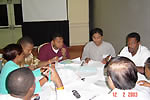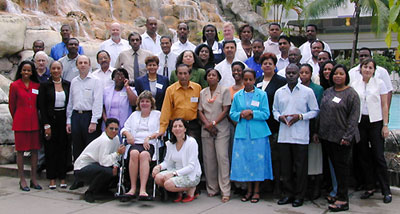|
1. Humanitarian and Development Context: Concepts and Definitions
Participants will be introduced to:
- The basic concepts and terms used in this field including: risk identification and assessment, risk reduction, strategic planning and disaster management.
- The current global and regional humanitarian and development context; appropriate strategies, ongoing programmes and action plans that shape risk reduction and disaster management practice and policy.
- The relationship between hazards, disasters and sustainable development, with a particular focus on Small-Island Developing States’ (SIDS) challenges.
- The changing risk profile for SIDS (dependence on coastal investments including tourism, climate change, infectious disease, terrorism etc.)

2. Managing Risks: Proactive Approaches
It is now generally recognized that much of the observed risk in societies and communities is linked to poor development decisions and programmes. The linkages between social, economic and environmental vulnerabilities will be explored. The several indicators and indices already developed will be presented. This module will look at the different disaster reduction interventions in place and other possible alternatives, using mainly health sector examples.
3. National Systems
 The different philosophies, traditional and institutional arrangements for risk identification, disaster preparedness and planning will be compared and contrasted. Case studies from a range of countries [and sectors] will be used to highlight the strengths and weaknesses of different [approaches] national systems. The allocation of roles and divisions of responsibilities in planning and implementation will be reviewed. Recent efforts to revisit, rationalize, institutionalize and legalize this process will be assessed. Emerging issues including public and private sector resilience, coping capacities and continuity of operations will be explored. The different philosophies, traditional and institutional arrangements for risk identification, disaster preparedness and planning will be compared and contrasted. Case studies from a range of countries [and sectors] will be used to highlight the strengths and weaknesses of different [approaches] national systems. The allocation of roles and divisions of responsibilities in planning and implementation will be reviewed. Recent efforts to revisit, rationalize, institutionalize and legalize this process will be assessed. Emerging issues including public and private sector resilience, coping capacities and continuity of operations will be explored.
4. Managing Emergencies
Participants will be introduced to the current sectoral, national, regional and international mechanisms for assisting nation states in coping with major crises. Recent experiences will be reviewed to highlight the various challenges involved in anticipating, avoiding, mobilizing for, coordinating and delivering an effective response, along with lessons learned from recent successes and failures.
5. Governance and Partnership Issues for Disaster Management
 Participants will be introduced to the dialogue on governance, and partnership building in disaster management, which is currently driven by the Organization for Economic Co-operation and Development - OECD October 2005 Declaration and principles elaborated by the UN. The implications for State and donor relations will be discussed. The integrated and comprehensive approach to disaster management, which is fully embraced within the Caribbean Region, through CDM, and which underpins the Hyogo Framework for Action (HFA), significantly widens the network of potential partnerships and actors. This raises important issues of ownership, power and accountability, both inside and outside government and government agencies. Participants will be introduced to the dialogue on governance, and partnership building in disaster management, which is currently driven by the Organization for Economic Co-operation and Development - OECD October 2005 Declaration and principles elaborated by the UN. The implications for State and donor relations will be discussed. The integrated and comprehensive approach to disaster management, which is fully embraced within the Caribbean Region, through CDM, and which underpins the Hyogo Framework for Action (HFA), significantly widens the network of potential partnerships and actors. This raises important issues of ownership, power and accountability, both inside and outside government and government agencies.
6. Information, Communication and Technology
Disaster preparedness and management requires the collection, collation and sharing of information among a diversity of actors. Participants will be introduced to the tools available to support effective risk communication, information sharing and management. Particular emphasis will be placed on the application of ICT in sharing Risk information, Early Warning Systems, mitigation and response planning. Examples from community health and early flood warning and mitigation planning will be shared and discussed.
7. Programming for Disaster Risk Reduction and Planning
Participants will be introduced to a suite of tools that can assist the design, elaboration and implementation of disaster management programmes which are integrated and sustainable. This will include strategic management, risk assessment, scenario planning, programme planning and project design, negotiations and communication.
8. Course Project Exercise
Course participants will be organized into teams, and each team will design and present a project centered around the application of one or more of the core themes of the course.

|